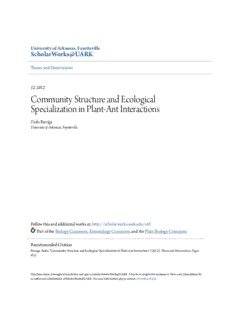
Community Structure and Ecological Specialization in Plant-Ant Interactions PDF
Preview Community Structure and Ecological Specialization in Plant-Ant Interactions
UUnniivveerrssiittyy ooff AArrkkaannssaass,, FFaayyeetttteevviillllee SScchhoollaarrWWoorrkkss@@UUAARRKK Graduate Theses and Dissertations 12-2012 CCoommmmuunniittyy SSttrruuccttuurree aanndd EEccoollooggiiccaall SSppeecciiaalliizzaattiioonn iinn PPllaanntt--AAnntt IInntteerraaccttiioonnss Paola Barriga University of Arkansas, Fayetteville Follow this and additional works at: https://scholarworks.uark.edu/etd Part of the Biology Commons, Entomology Commons, and the Plant Biology Commons CCiittaattiioonn Barriga, P. (2012). Community Structure and Ecological Specialization in Plant-Ant Interactions. Graduate Theses and Dissertations Retrieved from https://scholarworks.uark.edu/etd/625 This Dissertation is brought to you for free and open access by ScholarWorks@UARK. It has been accepted for inclusion in Graduate Theses and Dissertations by an authorized administrator of ScholarWorks@UARK. For more information, please contact [email protected]. COMMUNITY STRUCTURE AND ECOLOGICAL SPECIALIZATION IN PLANT-ANT INTERACTIONS COMMUNITY STRUCTURE AND ECOLOGICAL SPECIALIZATION IN PLANT-ANT INTERACTIONS A dissertation submitted in partial fulfillment of the requirement for the degree of Doctor of Philosophy in Biology By Paola A. Barriga Pontificia Universidad Católica del Ecuador Bachelor of Science in Biology, 2000 December 2012 University of Arkansas ABSTRACT Positive associations among species have contributed to the maintenance of biodiversity. These interactions are typically studied in pairwise fashion where two interacting organisms are the focus. This dissertation uses network theory to analyze positive plant-ant associations in three Neotropical forests. Obligate plant-ant mutualisms were used, where plants host the ants in domatia and provide food bodies while the ants protect the plants and can feed them. A network approach was used to depict all obligate plant-ant interactions within a community. The main questions asked at the community level were: 1) Do network structure and levels of specialization change geographically and, 2) What is the level of resilience of these associations if plants become extinct? I found that network structure and levels of specialization in three forests do not vary and that these associations are not resilient to host plant loss. In a second project I explored if traits of plants that host ants change between lowland and pre-montane tropical forests and if the differences impact plant-ant associations. Stable isotope analyses of plants and ants, in addition to plant measurements such as specific leaf area, trichome number, nitrogen per area and leaf thickness, were used. Plant traits differed by locale and by plant species. Location, but not ant species, affected herbivory. Finally, I explored the influence of ant metamorphosis, fat body and diet on stable isotope measurements. Stable isotope analysis is commonly used in ecological studies to determine trophic structure. However, the physiology of organisms analyzed can influence the results obtained. Fire ant colonies were used to explore if metamorphosis, fat body extraction and diet type impact isotopic signatures. Laboratory reared fire ant colonies were maintained with cricket and a sucrose diet. The addition of tuna to the diet was tested on additional colonies. Ant fats were dissolved using hexane-isopropanol or 95% ethanol. Metamorphosis had a significant effect only on δ15N and the availability of tuna produced further shifts in isotope ratios for all developmental stages. Treatment with organic solvents had no effect on δ13C, but resulted in enriched d15N values. This dissertation is approved for recommendation to the Graduate Council. Dissertation Director: _________________________________________ Dr. Cynthia L. Sagers Dissertation Committee: ___________________________________________ Dr. William J. Etges ___________________________________________ Dr. Gary R. Huxel ____________________________________________ Dr. Phyllis D. Coley DISSERTATION DUPLICATION RELEASE I hereby authorize the University of Arkansas Libraries to duplicate this dissertation when needed for research and/or scholarship. Agreed ____________________________________________ Paola A. Barriga Refused _____________________________________________ Paola A. Barriga ACKNOWLEDGMENTS Funding for this dissertation came from WWF’s (World Wildlife Fund) Russell E. Train Education for Nature Program, the Organization for Tropical Studies (Glaxo Fund), Sigma Xi Grants-in-Aid, and a Dissertation Research Award, Fulbright College of Arts and Sciences, University of Arkansas to PB, and NSF Office of International Science and Education grant # 0813594 to C. Sagers and N. Garwood. Support as a Teaching Assistantship was granted from the Department of Biological Sciences at the University of Arkansas. I acknowledge J. Trager, A. Wild, D. Donoso, J. Longino, W. Mackay for ant identifications/verifications, C. C. Berg, F. Michellangeli, D. Penneys, H. van der Weff, J. Gonzalez and J. P. Latorre for plant identification/verification. G. Alvia, E. Bellota and, R. Gonzales for field assistance, A. Smith for barcode cooperation, K. Kunn for her observations on Myrmelachista flavocotea at La Selva and A. Barragán, H. Navarrete, OTS-Peru, OTS-Costa Rica, and staff at these research stations for help with logistics and collecting permits. I also wish to thank my colleagues of the University of Arkansas Stable Isotope Lab for sample processing and to A. Dowling for the use of his equipment. I thank N. Blüthgen, P. Guimarães, P. Jordano, R. Colwell, E. LeBrun, L. Hart, S. Letcher, J. Stenken, T. Brenes-Arguedas, J. L. Hamrick, and M. Pires for discussion, comment and advice, and my graduate committee, W. J. Etges, G. R. Huxel, P. D. Coley, C. L. Sagers for their input. K. Polasky took care of my fire ant colonies. I thank to E. Gbur, J. Ludlam, C. Dormann, S. Lehnen, K. Thompson and G. Petris for statistical and programming advise. The Ministerio del Ambiente in Ecuador, the Ministerio de Agricultura in Perú and the Ministerio de Ambiente y Enegía in Costa Rica approved permits to do this research. Finally, special thanks go out to my family and friends. DEDICATION The journey to obtain this degree is dedicated to my grandparents Estuardo and María Esthela, my parents Víctor Hugo and Martha Susana, to Connie Tharel, William Eklund, my siblings and my sweet protector. TABLE OF CONTENTS 1. INTRODUCTION………………………………………………………………………...1 Literature cited …………………………………………………………………....…..9 2. Community structure and ecological specialization in plant-ant interactions ……..……13 Abstract…………………………………………………………………………........14 Introduction…………………………………………………………………………..16 Methods………………………………………………………………………………20 Results……………………………………………………………………………......27 Discussion……………………………………………………………………………32 Acknowledgements………………………………………………………………......40 Literature cited……………………………………………………………………….41 Tables………………………………………………………………………………...47 Figures………………………………………………………………………………..56 Appendix 2.1…………………………………………………………………………65 Appendix 2.2…………………………………………………………………………66 3. Functional trait variation and ant specialization in two plant-ant species in Costa Rica...67 Abstract………………………………………………………………………………68 Introduction…………………………………………………………………………..70 Methods……………………………………………………………………………....72 Results………………………………………………………………………………..76 Discussion……………………………………………………………………………80 Acknowledgements…………………………………………………………………..84 Literature cited……………………………………………………………………….85
Description: